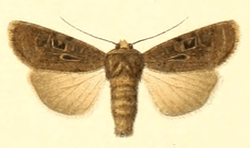Chersotis andereggii
Chersotis andereggii is a moth of the family Noctuidae.[1]
| Chersotis andereggii | |
|---|---|
 | |
| Illustration from The Macrolepidoptera of the World | |
 | |
| Chersotis andereggii. Mounted specimen | |
| Scientific classification | |
| Kingdom: | |
| Phylum: | |
| Class: | |
| Order: | |
| Family: | |
| Genus: | |
| Species: | C. andereggii |
| Binomial name | |
| Chersotis andereggii (Boisduval, [1837]) | |
| Synonyms | |
| |
Subspecies
- Chersotis andereggii andereggi (Alps)
- Chersotis andereggii arcana (southern Finland, northern Estonia)
- Chersotis andereggii subtilis (Himalayas (Ladakh))
Description
Chersotis andereggii has a wingspan of 29–32 mm. These relatively small moths are generally greyish-brown, with large dark orbicular and claviform markings.[2]
Biology
Adults are on wing from the end of July to the first half of August. The larvae feed on Lychnis, Melilotus and Trifolium species.[3]
Distribution
This species can be found in Europe (Bulgaria, East European Russia, Estonia, Finland, France, Greece, Italy, Switzerland),[4] in the southern Urals, Turkey, north-western Iran, Transcaucasia, Turkmenistan, Azerbaijan, Kirghizia, the Altai mountains, the Sayan Mountains, Baikal, Kamchatka, Mongolia, the Himalaya, the Alps.
Habitat
These moths live in alpine meadows and steppe slopes.[2]
Bibliography
- Erstbeschreibung: BOISDUVAL („1834“): Icones historique des lépidoptères d'Europe nouveaux ou peu connus 2: 1-192, pl. 47-84. Paris (Roret).
- COWAN, C. F. (1970): Boisduval's Icones Historiques des Lépidoptères d'Europe "1832" [-1841]. — Journal of the Society for the Bibliography of Natural History 5 (4): 291-302
- HUEMER, P. (2013): Die Schmetterlinge Österreichs (Lepidoptera). Systematische und faunistische Checkliste. – 304 S. (Studiohefte 12); Innsbruck (Tiroler Landesmuseen-Betriebsgesellschaft m.b.H.).
gollark: GTech™ hashmaps just precompute everything such that they can operate as vectors.
gollark: ?choose "eat drunk" "get garbage and watch neither "
gollark: ?choose "eat drunk", " get garbage and watch neither "
gollark: Yes.
gollark: Isn't that just puns?
References
- Biolib
- K Mikkola, J D Lafontaine, P Grotenfelt A revision of the Holarctic Chersotis andereggii complex (Lepidoptera, Noctuidae)
- Funet
- Fauna europaea
This article is issued from Wikipedia. The text is licensed under Creative Commons - Attribution - Sharealike. Additional terms may apply for the media files.